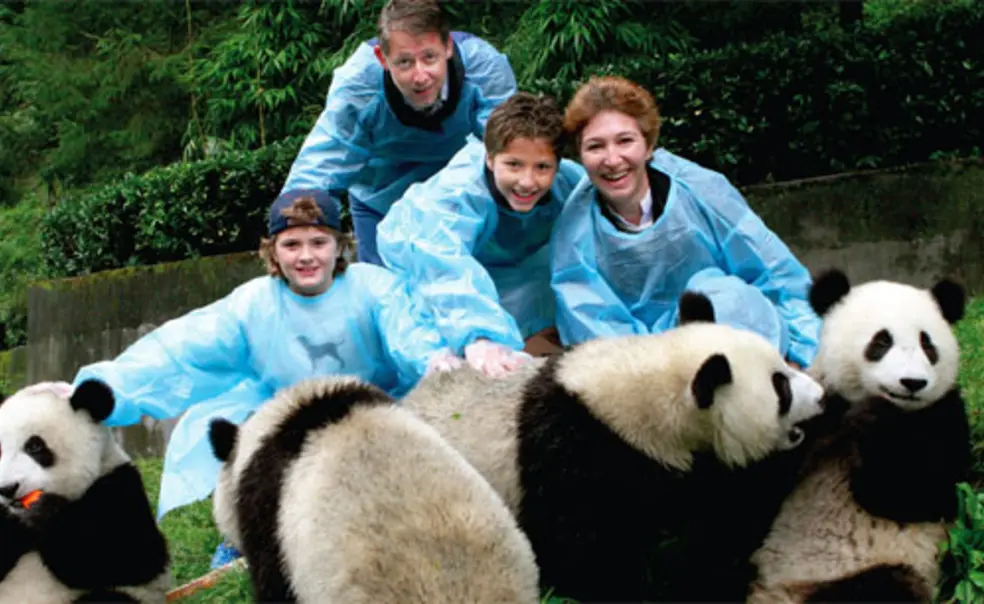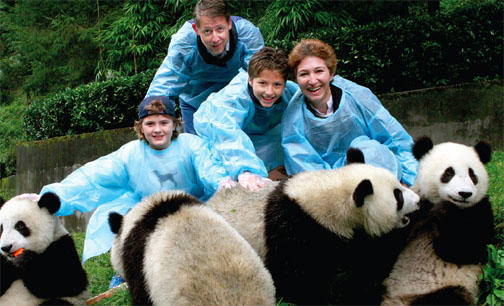What we learned in China
The Alumni Weekly provides these pages to the president.
The modernization of China is one of the great socioeconomic phenomena of our time, with far-reaching implications for the United States. Dean of the Woodrow Wilson School Anne-Marie Slaughter ’80, her husband, Professor of Politics and International Affairs Andrew Moravcsik, and their children spent last year in China, and I have invited Anne-Marie and Andy to share their impressions of this dramatically changing nation with you.—S.M.T.
Reflecting back on a 10-month sabbatical in Shanghai with our two sons, we are struck by what we learned about China, but equally how China changed our thinking about the rest of the world. To summarize our many insights in this brief space is impossible, but here are five things that surprised us.
1. No matter how prepared you are for the astonishing speed, growth, and diversity of China, the reality is faster and bigger than you expect. Shanghai has more skyscrapers than any city in the world—over 4,000—all built since the early 1990s. The aesthetic vision of the finest Chinese artists is on display at the Olympic opening ceremonies, in sound and light displays on the Li River, and in Beijing’s contemporary art scene. We traveled as widely in the country as we could, excluding the far north and west: most facilities were clean and efficient; Chinese food prepared to Chinese standards was fresh and tasty. (The only time anyone got sick was when we made the mistake of ordering the kids a Western pizza in the mountains of Yunnan.) We saw a great deal of poverty, but also continually saw evidence of China’s commitment to raising the standards of living far from the go-go centers of the east coast. 2. For all its dynamism and development, however, China has a long way to go. Its economic miracle rests on more fragile foundations than most visitors realize. Hundreds of millions have risen from poverty, but some 700 million remain behind. The medical system is broken. Educational opportunities are unequal. Rapid urbanization has disrupted traditional social and familial networks, leaving many young people working in cities far from home. A leading Chinese marketing executive told us: “Loneliness is big business in China.” As Susan Shirk explains in her excellent book Fragile Superpower, China’s leaders fear the roiling social forces just below the surface and are very careful to monitor broad social organizations of any kind.
3. Though much of China remains a developing country, it is not the historical China. China’s “5,000 years of history” are more visible in rhetoric than in reality. Consider modern China’s architectural makeover. A century of turmoil—imperialism, the Boxer Rebellion, the fall of Imperial China, Japanese invasion, civil war and national division, Chinese and Cultural Revolutions, mass migration, urban renewal, economic development—have destroyed almost all China’s architectural heritage. The standard two-week tour through China (the Great Wall, Forbidden City, Terra-cotta Warriors, etc.) is misleading. Little remains of China’s ancient urban environment. The Japanese leveled much of Nanjing. Mao razed Beijing’s venerable city walls and stripped away Tiananmen’s facades. Ninety percent of the remaining urban architecture was bulldozed under skyscrapers. What little has been “restored” feels Disney-esque. One comes to realize how destructive history can be, and how difficult it is to preserve it. It is a miracle that cities like Rome, Prague, Istanbul, Buenos Aires, and Hanoi still exist in the world, in which the past remains present.
4. The same set of 20th-century historical catastrophes also marks a deep psychological break for the Chinese people. China today is in fact a new nation, where people know and care little about anything that occurred more than a decade ago, or just prefer to forget. The economy has begun anew. High culture is disappearing fast. Chinese clothing and style are international rather than indigenous. Deng Xiaoping is the only historical political figure of relevance. Mao is a distant memory, far more present as a kitsch icon than a serious symbol. All this impoverishes Chinese cultural life, but it also frees the Chinese to be refreshingly pragmatic and open to many new opportunities.
5. The absence of history in China gave us a new perspective on what it means to live in a developed country. Yes, it means living with the new, but it also means living with layers of the old. This insight crystallized the day we returned home. We began by driving from our 3-year old Shanghai apartment along a new multi-lane highway to the new Shanghai airport terminal. It runs alongside the (German-designed) magnetic levitation (Maglev) train that floats at 431-km-per-hour on a cushion of air. At the other end, we landed at Newark Airport and headed down the New Jersey Turnpike to Princeton. On the surface, the two journeys seemed the same—indeed, the American end was superficially less impressive. NJ Transit, despite the new double-decker cars, is no Maglev!
So what was it precisely that told us we were back in a developed country? Gradually the difference came to us: in China there is only one layer of infrastructure, a shiny new layer. In the U.S., by contrast, you see multiple layers: old streetlights next to newer ones, different kinds of asphalt dating from different periods, old and new cars on the road, old and new factories, shopping centers, and houses beside the road. Paradoxically, the sign of a mature and developed country is the presence of old things intermixed with the new—the palpable presence of history.













No responses yet